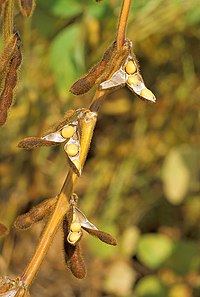
14C labelling as a reliable technique to screen soybean genotypes (Glycine max (L.) Merr.) for iron deficiency tolerance
Sign Up to like & getrecommendations! Published in 2019 at "Journal of Radioanalytical and Nuclear Chemistry"
DOI: 10.1007/s10967-019-06708-1
Abstract: Fifty diverse soybean genotypes were screened for their ability to tolerate iron deficiency stress in a hydroponics experiment with low iron (−Fe) and sufficient iron (+Fe). We hypothesised that the genotypes with higher root exudation… read more here.
Keywords: soybean genotypes; iron; 14c labelling; iron deficiency ... See more keywords

Dry matter partitioning and K distribution of vegetable soybean genotypes with higher potassium efficiency
Sign Up to like & getrecommendations! Published in 2019 at "Archives of Agronomy and Soil Science"
DOI: 10.1080/03650340.2019.1638508
Abstract: ABSTRACT Field and pot experiments were conducted to select and identify the characteristics of potassium (K) high efficiency vegetable soybean genotypes. Forty genotypes under two potassium application levels (0, 120 kg ha−1 K2SO4) showed variations… read more here.
Keywords: vegetable soybean; potassium; dry matter; soybean genotypes ... See more keywords

Assessing Soybean Genotypes for Resistance to Helicoverpa armigera (Lepidoptera: Noctuidae)
Sign Up to like & getrecommendations! Published in 2019 at "Journal of Economic Entomology"
DOI: 10.1093/jee/toz269
Abstract: Abstract Helicoverpa armigera (Hübner) (Lepidoptera: Noctuidae) is an important pest capable of colonizing several species of cultivated plants, including soybean [Glycine max (L.) Merrill]. The primary management strategy for this insect is chemical control and… read more here.
Keywords: helicoverpa armigera; lepidoptera noctuidae; armigera; resistance ... See more keywords

Evaluation of soybean genotypes for resistance against the rust‐causing fungus Phakopsora pachyrhizi in East Africa
Sign Up to like & getrecommendations! Published in 2021 at "Plant Pathology"
DOI: 10.1111/ppa.13339
Abstract: Soybean rust, caused by the biotrophic fungus Phakopsora pachyrhizi, is the most important foliar disease of soybean (Glycine max) worldwide. Deployment of resistant soybean cultivars is the best option for managing this disease. Genes conferring… read more here.
Keywords: rust; resistance; soybean genotypes; phakopsora pachyrhizi ... See more keywords

Growth and transpiration of soybean genotypes with HaHB4® transcription factor for drought tolerance.
Sign Up to like & getrecommendations! Published in 2021 at "Physiologia plantarum"
DOI: 10.1111/ppl.13557
Abstract: The expression of HaHB4® transcription factor reduces soybean sensitivity to abiotic stresses, such as water deficit. Studies that quantify the tolerance of HaHB4® soybean to the soil water content in comparison with cultivars currently sown… read more here.
Keywords: soybean; water; transpiration; transcription factor ... See more keywords

Changes in the Metabolome of Two Soybean Genotypes under Drought Stress
Sign Up to like & getrecommendations! Published in 2020 at "Russian Journal of Plant Physiology"
DOI: 10.1134/s1021443720030085
Abstract: Abstract Soybean is the world’s leading economic oilseed crop. Drought stress is a major constraint on the growth and yield stability of soybean. Here, wild soybean ( Glycine soja Siebold & Zucc.) was found to… read more here.
Keywords: drought stress; two soybean; wild soybean; soybean genotypes ... See more keywords

High-throughput phenotyping allows the selection of soybean genotypes for earliness and high grain yield
Sign Up to like & getrecommendations! Published in 2022 at "Plant Methods"
DOI: 10.1186/s13007-022-00848-4
Abstract: Background Precision agriculture techniques are widely used to optimize fertilizer and soil applications. Furthermore, these techniques could also be combined with new statistical tools to assist in phenotyping in breeding programs. In this study, the… read more here.
Keywords: grain yield; high throughput; throughput phenotyping; soybean genotypes ... See more keywords

Yield of soybean genotypes identified through GGE biplot and path analysis
Sign Up to like & getrecommendations! Published in 2022 at "PLoS ONE"
DOI: 10.1371/journal.pone.0274726
Abstract: Genotype × environment (G×E) interaction is an important source of variation in soybean yield, which can significantly influence selection in breeding programs. This study aimed to select superior soybean genotypes for performance and yield stability,… read more here.
Keywords: gge biplot; yield; soybean genotypes; path analysis ... See more keywords

Adaptability and productive stability of soybean genotypes under natural rust infection without fungicide
Sign Up to like & getrecommendations! Published in 2018 at "Bioscience Journal"
DOI: 10.14393/bj-v34n5a2018-41559
Abstract: The genetic breeding of soybean aims to obtain productive genotypes, so it is necessary that the genetic components, environment and the interaction between them be understood. The G x E interaction is the differential behavior… read more here.
Keywords: soybean; genotypes natural; adaptability; stability soybean ... See more keywords

Reproduction of Meloidogyne javanica in soybean genotypes.
Sign Up to like & getrecommendations! Published in 2022 at "Anais da Academia Brasileira de Ciencias"
DOI: 10.1590/0001-3765202220191427
Abstract: Meloidogyne javanica is among the most important nematodes that damage soybean, and although genetic resistance is the ideal control measure, there are few cultivars described as resistant among those recommended for southern Brazil. The objective… read more here.
Keywords: javanica; meloidogyne javanica; soybean genotypes; reproduction meloidogyne ... See more keywords

Rhizosphere Soil Fungal Communities of Aluminum-Tolerant and -Sensitive Soybean Genotypes Respond Differently to Aluminum Stress in an Acid Soil
Sign Up to like & getrecommendations! Published in 2020 at "Frontiers in Microbiology"
DOI: 10.3389/fmicb.2020.01177
Abstract: Different soybean genotypes can differ in their tolerance toward aluminum stress depending on their rhizosphere-inhabiting microorganisms. However, there is limited understanding of the response of fungal communities to different aluminum concentrations across different genotypes. Here,… read more here.
Keywords: aluminum; aluminum stress; stress; soybean genotypes ... See more keywords